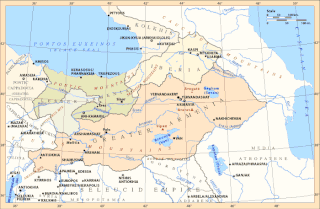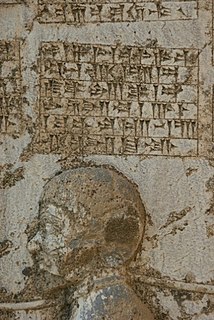Patigrabana was a historical city in Parthia. [1] It is known of only from the Behistun Inscription.
According to that text, Patigrabana is where Hystaspes – father of Darius I and Achaemenid governor of Parthia – fought a battle against Parthian and Hyrcanian rebels supporting one Phraortes (not to be confused with the earlier Median emperor of the same name) around 520 BC. Hystaspes had earlier fought a battle against them at Vishpauzati. He was reinforced by Achaemenid troops from Rhagae, then attacked and defeated the rebels at Patigrabana and secured Parthia for Darius.
Its name means "place where goods are collected," and the city may have been located at the present-day site of Mashhad. [2]

The Behistun Inscription is a multilingual inscription and large rock relief on a cliff at Mount Behistun in the Kermanshah Province of Iran, near the city of Kermanshah in western Iran, established by Darius the Great. It was crucial to the decipherment of cuneiform script as the inscription includes three versions of the same text, written in three different cuneiform script languages: Old Persian, Elamite, and Babylonian. The inscription is to cuneiform script what the Rosetta Stone is to Egyptian hieroglyphs: the document most crucial in the deciphering of a previously lost writing system.

Darius I, commonly known as Darius the Great, was a Persian ruler who served as the third King of Kings of the Achaemenid Empire, reigning from 522 BCE until his death in 486 BCE. He ruled the empire at its territorial peak, when it included much of Western Asia, parts of the Balkans and the Caucasus, most of the Black Sea's coastal regions, Central Asia, the Indus Valley in the far east, and portions of North Africa and Northeast Africa including Egypt (Mudrâya), eastern Libya, and coastal Sudan.

Bardiya, also named as Tanyoxarces by Ctesias, was a son of Cyrus the Great and the younger brother of Cambyses II, both Persian kings. There are sharply divided views on his life. Bardiya either ruled the Achaemenid Empire for a few months in 522 BC, or was impersonated by a magus called Gaumāta ; whose name is given by Ctesias as Sphendadates, until he was toppled by Darius the Great.

Hyrcania is a historical region composed of the land south-east of the Caspian Sea in modern-day Iran and Turkmenistan, bound in the south by the Alborz mountain range and the Kopet Dag in the east.

Ariaramnes was a great-uncle of Cyrus the Great and the great-grandfather of Darius I, and perhaps the king of Parsa, the ancient core kingdom of Persia.

Arsames was the son of Ariaramnes and the grandfather of Darius I. He was traditionally claimed to have briefly been king of Persia during the Achaemenid dynasty, and to have given up the throne and declared loyalty to his relative Cyrus II of Persia before retiring to his family estate in the Persian heartland of Parsa, living there peacefully for the rest of his life, perhaps nominally exercising the duties of a "lesser king" under the authority of the "Great King". However, the claim that he or his son were ever kings is rejected by historians such as Pierre Briant. In an inscription allegedly found in Hamadan he is called "king of Persia", but the document is widely argued to be a fake, either modern or ancient. Another attestation of his reign is the Behistun Inscription, where his grandson Darius I lists him among his ancestors, although he does not explicitly mention him as being one of the anonymous eight kings whom he claims preceded him.
Gobryas was a common name of several Persian noblemen.
The Orontid dynasty, also known by their native name Eruandid or Yervanduni, was a hereditary dynasty that ruled the Satrapy of Armenia until 330BC and the Kingdom of Armenia from 321BC to 200BC.

The Satrapy of Armenia, a region controlled by the Orontid dynasty, was one of the satrapies of the Achaemenid Empire in the 6th century BC that later became an independent kingdom. Its capitals were Tushpa and later Erebuni.

Old Persian cuneiform is a semi-alphabetic cuneiform script that was the primary script for Old Persian. Texts written in this cuneiform have been found in Iran, Armenia, Romania (Gherla), Turkey, and along the Suez Canal. They were mostly inscriptions from the time period of Darius I, such as the DNa inscription, as well as his son, Xerxes I. Later kings down to Artaxerxes III used more recent forms of the language classified as "pre-Middle Persian".

Nebuchadnezzar IV, alternatively spelled Nebuchadrezzar IV and also known by his original name Arakha, was a nobleman of Urartian (Armenian) descent who in 521 BC seized power in Babylon, becoming the city's king and leading a revolt against the Persian Achaemenid Empire. His revolt began less than a year after the unsuccessful revolt of Nebuchadnezzar III and like his predecessor, Arakha assumed the name Nebuchadnezzar and claimed to be a son of Nabonidus, Babylon's last independent king.

Bactria was a satrapy of the Achaemenid Empire. It was conquered between 545–540 BC by Cyrus the Great.

Ionia, known in Old Persian as Yauna, was a region within the satrapy of Lydia, with its capital at Sardis, within the First Persian Empire. The first mention of the Yauna is at the Behistun inscription.

Seheruibre Padibastet better known by his Hellenised name Petubastis III was a native ancient Egyptian ruler, who revolted against Persian rule.

Parthia is a historical region located in north-eastern Iran. It was conquered and subjugated by the empire of the Medes during the 7th century BC, was incorporated into the subsequent Achaemenid Empire under Cyrus the Great in the 6th century BC, and formed part of the Hellenistic Seleucid Empire following the 4th-century-BC conquests of Alexander the Great. The region later served as the political and cultural base of the Eastern-Iranian Parni people and Arsacid dynasty, rulers of the Parthian Empire. The Sasanian Empire, the last state of pre-Islamic Iran, also held the region and maintained the Seven Parthian clans as part of their feudal aristocracy.

Nebuchadnezzar III, alternatively spelled Nebuchadrezzar III and also known by his original name Nidintu-Bêl, was a rebel king of Babylon in late 522 BC who attempted to restore Babylonia as an independent kingdom and end the rule of the Persian Achaemenid Empire in Mesopotamia. A Babylonian noble of the Zazakku family and the son of a man by the name of Mukīn-zēri or Kîn-Zêr, Nidintu-Bêl took the regnal name Nebuchadnezzar upon his accession to the Babylonian throne and claimed to be a son of Nabonidus, Babylon's last independent king.

Hystaspes or Guštāsp, was a Persian satrap of Bactria and Persis. He was the father of Darius I, emperor of the Achaemenid Empire, and Artabanus, who was a trusted advisor to both his brother Darius as well as Darius's son and successor, Xerxes I.

The Achaemenid Empire, also called the First Persian Empire, was an ancient Iranian empire that was based in Western Asia and founded by Cyrus the Great in 550 BC. It reached its greatest extent under Xerxes I, who conquered most of northern and central ancient Greece. At its greatest territorial extent, the Achaemenid Empire stretched from the Balkans and Eastern Europe in the west to the Indus Valley in the east. The empire was larger than any previous empire in history, spanning a total of 5.5 million square kilometres.

The Achaemenid conquest of the Indus Valley occurred from the 6th to 4th centuries BCE, and saw the Achaemenid Persian Empire take control of regions in the northwestern Indian subcontinent that predominantly comprise the territory of modern-day Pakistan. The first of two main invasions was conducted around 535 BCE by the empire's founder, Cyrus the Great, who annexed the regions west of the Indus River that formed the eastern border of the Achaemenid Empire. Following Cyrus' death, Darius the Great established his dynasty and began to re-conquer former provinces and further expand the empire. Around 518 BCE, Persian armies under Darius crossed the Himalayas into India to initiate a second period of conquest by annexing regions up to the Jhelum River in Punjab.
The Achaemenid Kingdom refers to the pre-imperial history of the Achaemenid dynasty. The first king of the kingdom was Achaemenes, who was the forefather of the Achamenids, and who also gave his name to the dynasty. The Achaemenid kingdom was the ruling kingdom of Persia and Anshan.